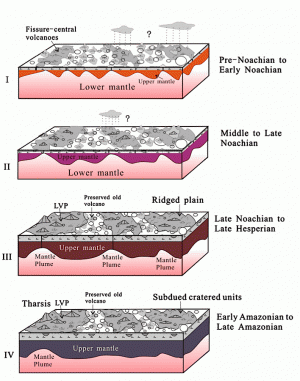Mars is a volcanic planet and has been volcanically active from the start. The most extensive volcanism occurred during the earliest part of its geologic history, the Noachian era, the time before roughly 3.7 billion years ago.

VOLCANIC ACTIVITY EVOLVED from mainly plains volcanism in stage I to regional activity (II) to big volcano building from volcanic plumes (III) to finally recent small shield volcanos and plains volcanism again (IV). (Image is Figure 6 from the paper.)
However, as a group of Mars geologists led by Long Xiao (China University of Geosciences) write in Earth and Planetary Science Letters, “long-term and significant geologic modification, heavy degradation, and resurfacing processes complicate the identification and characterization of the volcanos produced in the Noachian.”
The scientists used imaging data from THEMIS, HRSC, and CTX cameras to identify and study 75 early Noachian volcanos in the southern highlands. The regions studied are mostly south of Tharsis and in the circum-Hellas volcanic region.
Although these areas are heavily cratered, the volcanos lie in areas mapped previously as hilly features — mesas, knobs, and broad areas that rise above the local terrain. According to the scientists, recent and more complete imagery reveals these features are chiefly isolated structures and thus not caused by tectonic activity or impacts.
Many of the volcanos showed signs such as radial channels that suggest either fluvial or lava erosion, the scientists noted. They found that Noachian volcanos “occur as shields and lava plains and have mostly been modified by impact craters and channels, while Hesperian [i.e., younger] volcanism is primarily flood lavas and a number of low shield volcanos.”
Putting together the overall picture, the team suggests that these Noachian volcanos are the oldest surviving ones on Mars (and perhaps in the solar system). They also argue that, “Most of these features are adjacent to or partially overlap the Tharsis Province and the circum-Hellas Volcanic Province.” This suggests, the team says, that “these ancient volcanos are part of these two large volcanic provinces, possibly indicating that the volcanic histories of these provinces was longer than previously thought.”








